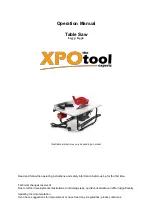
5
ENGLISH
◆
Move the blade clamp lever (5) down to lock the blade
clamping mechanism.
◆
Remove the tooth protector, if fitted.
Note: This tool has been designed to allow the saw blades to
be fitted with the teeth facing forward or backward.
Use
Charging the battery (fig. A)
The battery needs to be charged before first use and whenever
it fails to produce sufficient power on jobs that were easily
done before. When charging the battery for the first time, or
after prolonged storage, it will only accept an 80% charge.
After several charge and discharge cycles, the battery will
attain full capacity. The battery may become warm while
charging; this is normal and does not indicate a problem.
Warning!
Do not charge the battery at ambient temperatures
below 4 °C or above 40 °C. Recommended charging
temperature: approx. 24 °C.
◆
To charge the battery (6), remove it from the tool.
◆
Slide the charger receptacle (9) onto the battery as shown.
◆
Plug in the charger (8). Switch on at the mains.
The battery will become warm while charging. After approx.
3 hours of charging, the battery will be sufficiently charged for
use in regular applications. After approx. 6 hours of charging,
the battery will be fully charged.
◆
Remove the charger receptacle from the battery.
Switching on and off
◆
To switch the tool on, move the lock-off button (2) into the
unlock position and squeeze the on/off switch (1).
◆
To switch the tool off, release the on/off switch.
Sawing (fig. C)
◆
Always hold the tool with both hands.
◆
Let the blade run freely for a few seconds before starting
the cut.
◆
Apply only a gentle pressure to the tool while performing
the cut.
◆
If possible, work with the shoe pressed against the
workpiece. This will improve tool control and reduce tool
vibration, as well as prevent the blade from being damaged.
Hints for optimum use
Sawing wood
◆
Clamp the workpiece securely and remove all nails and
metal objects.
◆
Holding the tool with both hands, work with the shoe
pressed against the workpiece.
Pocket cutting in wood
◆
Measure and mark the required pocket cut.
◆
Fit a saw blade suitable for pocket cutting.
◆
Rest the shoe on the workpiece in such a position that the
blade forms an appropriate angle for the pocket cut.
◆
Switch on the tool and slowly feed the blade into the
workpiece. Make sure that the shoe remains in contact
with the workpiece at all times.
Sawing metal
◆
Be aware that sawing metal takes much more time than
sawing wood.
◆
Use a saw blade suitable for sawing metal.
Use a fine-tooth saw blade for ferrous metals and a
coarser saw blade for nonferrous metals.
◆
When cutting thin sheet metal, clamp a piece of scrap
wood to the back surface of the workpiece and cut
through this sandwich.
◆
Spread a film of oil along the intended line of cut.
Cutting branches
Branches up to 25 mm in diameter can be cut with this tool.
Warning!
Do not use the tool while in a tree, on a ladder or
on any other unstable surface. Be aware of where the branch
will fall.
◆
Cut downward and away from your body.
◆
Make the cut close to the main branch or tree body.
Vertical cutting
The tool allows close cutting to corners and other difficult areas.
◆
Insert the shank of the saw blade into the blade holder
with the teeth of the blade facing upward.
◆
Hold the tool with the shoe facing downward so that you
are as close to the work surface as possible.
◆
Cut forward and away from your body.
Accessories
The performance of your tool depends on the accessory used.
Black & Decker and Piranha accessories are engineered to
high quality standards and designed to enhance the
performance of your tool. By using these accessories you will
get the very best from your tool.
MAINTENANCE
Your Black & Decker tool has been designed to operate over a
long period of time with a minimum of maintenance.
Continuous satisfactory operation depends upon proper tool
care and regular cleaning. Your charger does not require any
maintenance apart from regular cleaning.






































